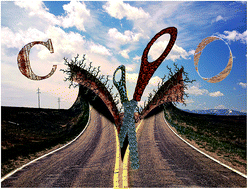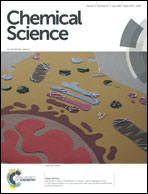Efficient cleavage of aryl ether C–O linkages by Rh–Ni and Ru–Ni nanoscale catalysts operating in water†
Abstract
Bimetallic Ru–Ni and Rh–Ni nanocatalysts coated with a phase transfer agent efficiently cleave aryl ether C–O linkages in water in the presence of hydrogen. For dimeric substrates with weaker C–O linkages, i.e. α-O-4 and β-O-4 bonds, low loadings of the precious metal (Rh or Ru) in the nanocatalysts quantitatively afford monomers, whereas for the stronger 4-O-5 linkage higher amounts of the precious metal are required to achieve complete conversion. Under the optimized, relatively mild operating conditions, the C–O bonds in a range of substituted ether compounds are efficiently cleaved, and mechanistic insights into the reaction pathways are provided. This work paves the way to sustainable approaches for the hydrogenolysis of C–O bonds.

- This article is part of the themed collection: Most popular 2018-2019 nanoscience articles


 Please wait while we load your content...
Please wait while we load your content...